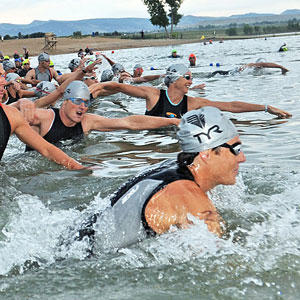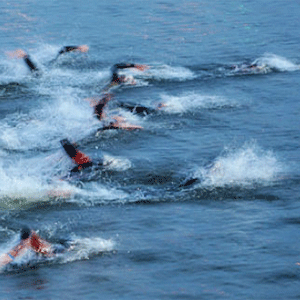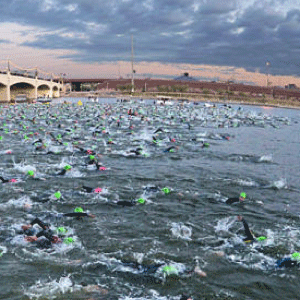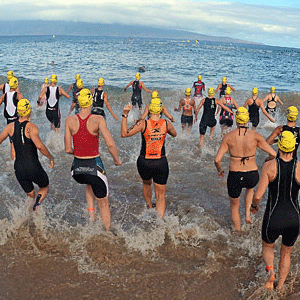Swim changes for NA Ironmans

Ironman competitors will endure, or enjoy — depending on one’s outllook — a change in how swim starts will be conducted in many North American Ironman swim venues. Some will like what they read, some will not. The motive driving these swim venue changes is swim safety and engendering the sense among competitors while they race that they are swimming in a safe environment.
The changes in swim starts are the only things most athletes will talk and think about. But these swim start strategies are part of a larger program WTC is announcing today that extends to how the swim is monitored and conducted after the swim commences, along with the sorts of pre-race education that have been loudly advocated here on Slowtwitch.
These changes, taken in toto, are the framwork for what WTC calls SwimSmart, and WTC intends this to be a work in progress as tactics and policies prove themselves popular and efficacious, or fall short of these goals.
Venue and start changes
Some swim venues do not allow for a wide enough start line. This means competitors must line up deep rather than wide. Any who’ve run in, or seen, a big city marathon you can envision the problem. In a race like the Boston Marathon it may take 20 minutes, 30 minutes or more just to get to the start line. However, one’s official time is one’s chip time. Cross the start line 2 minutes after the gun goes off, your finish time is the clock time minus those 2 minutes.
The Ironman races in Coeur d’Alene and Lake Placid are going to take place under these conditions and rules. Your official time, and place, will follow your chip time. You may finish behind someone in your age group and still prevail in the results.
Contrary to what has been written on the Slowtwitch Reader Forum, Coeur d’Alene is not a time trial start. Rather, it’s a rolling start. But it’s still a mass start. Swimmers self-seed according to their swim times, and it’s really worth a swimmer’s while not to try to game this through self-seeding forward to a faster group. Imagine a bike race, where your finish time is based on chip time, and you can either start with the Pro/1/2 group, Cat 3, Cat 4 and so forth. If you start with the Pro field and get dropped immediately, were you better off? If you start with the Cat 4 group and you can ride that group’s pace, isn’t that going to be a better option? Likewise in the swim. The draft in the swim is just as important as on the bike, so, if you start with those who swim your pace, you’ll be more likely to find and hang onto the feet of swimmers who’re swimming your pace.
You’re also, of course, much less likely to have someone swim over you, and that’s precisely what WTC is hoping to avoid through this start scheme. All athletes will have a full 17 hours of chip time to complete the course, and incremental swim and bike cut-off times will be likewise adjusted so that chip times are the arbiters.
Ironman races in Lake Tahoe and Florida will adopt the self-seeding motif described above, but will not adopt chip time as the determiner of finish time, cut-off times and placings.
Ironman Mt. Tremblant will feature wave starts, by age group. This makes the starts smaller and less chaotic and frenetic, but allows head-to-head, straight up racing between cohorts in competitive sets.
All other races will remain as they have been, with swim starts contested as has been the case. One might ask why all Ironman races do not adopt either a self-seeded swim motif, or a rolling start with a finish result based on chip time? For some races neither is practical, and in-water starts — like Arizona — are cases in point.
Warm-up areas
Not all Ironman races allow for a warm-up. Not all races allow for a warm-up, specifically but not limited to swims that take place in rivers or any body of water with a current. But WTC acknowledges the value of a warm-up and going forward most of its races will have a designated warm-up area, with the admonition to contestants to use that area to good effect.
Pre-race Education
WTC has absorbed the truism that by the time an athlete arrives at the start line, the ship has sailed on most of what that athlete can or could’ve done to prevent a crisis in the water. To be sure, a high percentage of sudden cardiac deaths that are unforseeable, unpredictable, unavoidable. WTC has filmed and is in the process of producing a video designed to educate its contestants on what we know about crises in the water and how they might be avoided. It has aggregated best practices from various experts and thrown them into this video, or into the mechanics of its swim starts and in-water swim safety.
The video focuses on athlete behavior. Are you contemplating a wetsuit swim in the race you’ve entered? Do you have your wetsuit and does it fit? Have you used your wetsuit, particularly in open water? How much recent open water experience do you have and what are the opportunities to add to that experience before the race? What can you do to begin the swim ready and equipped, abating anxiety and physiologically preparing for a frenetic start through a proper warm-up if the venue allows for it? There will also be a mention of the American Heart Association’s 12-step screening that almost any doctor can perform.
If you are an Ironman competitor it is highly likely this video and perhaps other associated information will be presented to you some months prior to the event in which you’re entered.
In-water safety enhancements
Ironman swims will feature rafts at regular intervals so that contestants may rest if so desired. Resting on these rafts will not constitute a rules infraction, nor will resting on a paddleboard or other device or watercraft.
Also, WTC announced today that no swim will be conducted in water colder than 52 degrees or warmer than 88 degrees.





